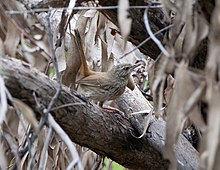
The eastern rosella is a rosella native to southeastern Australia, including Tasmania.

The plumed whistling duck, also called the grass whistling duck, is a whistling duck that breeds in Australia. It is a predominantly brown-coloured duck with a long neck and characteristic plumes arising from its flanks. The sexes are similar in appearance.

The chestnut woodpecker a species of bird in subfamily Picinae of the woodpecker family Picidae. It is found on Trinidad and in every mainland South American country except Argentina, Chile, Paraguay, and Uruguay.

The yellow-rumped thornbill is a species of passerine bird from the genus Acanthiza. The genus was once placed in the family Pardalotidae but that family was split and it is now in the family Acanthizidae. There are four subspecies of yellow-rumped thornbill. It is a small, brownish bird with a distinctive yellow rump and thin dark bill. It inhabits savannah, scrub and forests across most of Australia and eats insects. The species engages in cooperative breeding.

The olive whistler or olivaceous whistler, is a species of bird in the family Pachycephalidae, the whistlers, that is native to southeastern Australia.
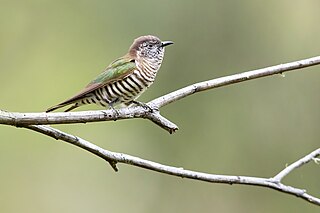
The shining bronze cuckoo is a species of cuckoo in the family Cuculidae, found in Australia, Indonesia, New Caledonia, New Zealand, Papua New Guinea, Solomon Islands, and Vanuatu. It was previously also known as Chalcites lucidus.

The red-backed kingfisher is a species of kingfisher in the subfamily Halcyoninae, also known as tree kingfishers. It is a predominantly blue-green and white bird with a chestnut rump. It is found across the continent of Australia, mainly inhabiting the drier regions.

The chestnut-rumped thornbill is a small passerine bird in the family Acanthizidae, endemic to Australia.
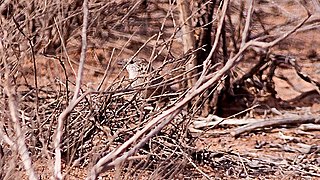
The thick-billed grasswren is a species of bird in the family Maluridae. It is endemic to Australia. Its natural habitat is Mediterranean-type shrubby vegetation.

The rufous fieldwren also known as the desert wren or sandplain wren is a species of insectivorous bird in the family Acanthizidae, endemic to Australia.

The speckled warbler is a species of bird in the family Acanthizidae. It is endemic to eastern Australia. Its natural habitat is temperate forests.

The chestnut-breasted wren is a species of bird in the family Troglodytidae. It is found in Colombia, Ecuador, Peru and Bolivia.

The shy heathwren is a species of small bird in the family Acanthizidae, endemic to Australia. They inhabit mostly mallee woodland that has relatively dense shrub and heath understorey.

Hylacola is a genus of bird in the family Acanthizidae.
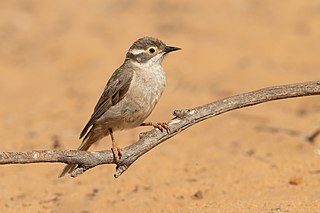
The brown-headed honeyeater is a species of passerine bird in the family Meliphagidae. It is endemic to Australia. Its natural habitats are temperate forests and Mediterranean-type shrubby vegetation.

The pilotbird is a species of passerine bird in the family Acanthizidae. It is monotypic within the genus Pycnoptilus. The species is endemic to south-eastern Australia.

The redthroat is a small, mostly ground-dwelling species of bird in the family Acanthizidae. It is endemic to Australia, occurring mostly in arid and semi-arid areas containing acacia and chenopod shrublands. The species has a distinctive red throat patch and is able to mimic the calls of numerous other bird species.

The grey-throated leaftosser is a Near Threatened species of bird in the subfamily Sclerurinae, the leaftossers and miners, of the ovenbird family Furnariidae. It is found in Bolivia, Brazil, Colombia, Costa Rica, Ecuador, Panama, Peru, Trinidad and Tobago, and Venezuela.
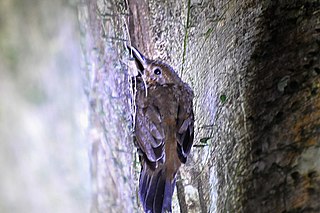
The short-billed leaftosser is a species of bird in the subfamily Sclerurinae, the leaftossers and miners, of the ovenbird family Furnariidae. It is found in Bolivia, Brazil, Colombia, Ecuador, French Guiana, Guyana, Peru, Suriname, and Venezuela.

The large-billed scrubwren is a passerine bird in the family Acanthizidae, endemic to eastern Australia. It is found in denser undergrowth in temperate forest, subtropical or tropical moist lowland forest, and subtropical or tropical moist montane forest.
